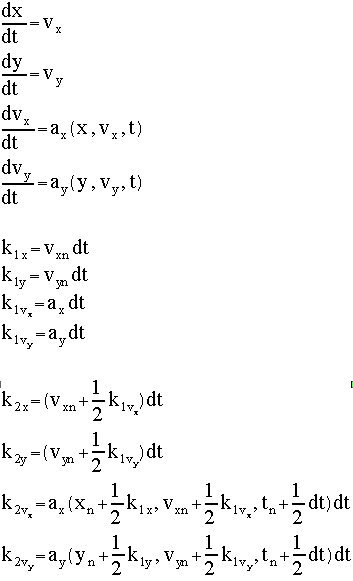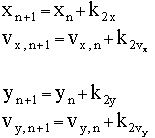
| Home : Map : Chapter 4 : Java : Tech : Physics : |
|
Demo 1: Projectile Motion with 2nd Order R-K
|
| JavaTech |
| Course Map |
| Chapter 4 |
|
Introduction
|
| Supplements
Override/Overload Annotation-J2SE5.0 Java Security Class Loading Class Verifier SecurityManager |
| About
JavaTech Codes List Exercises Feedback References Resources Tips Topic Index Course Guide What's New |
|
The 2nd Order Runge-Kutta formula shown above is for a single variable x, which would suffice for determining the motion of a falling object or for an object on spring. For projectile motion, though, we deal with two coordinates. We thus need formulas for both vertical (y) and horizontal (x) variables: and then Below we show the code for a second order Runge-Kutta class that generalizes the above formulas to multiple variables. Array arguments carry the variables and their derivative. Here we use the name vel, as in velocity, for the derivatives but these could be derivatives with respect to a non-time related variable. The derivative of the velocity comes from an interface method called Derivable, shown below. The method modifier static eliminates the need to create an instance of the class.
The program below uses the second order Runge-Kutta code above to solve for the intercept of a projectile with the horizontal plane. Ignoring air drag (see the exercises), the horizontal force is zero and the vertical force is a constant. Note how the class implements the interface and overrides its method.
The output shows
This compares to a value of 1020.4 for the analytical solution. Exercise : Try a finer dt value to see if the intercept makes a better match to the analytical value. Exercise : The program checks if the projectile vertical coordinate has become negative to indicate that the object has reached the surface. However, this can overestimate the horizontal intercept. Add code to do an interpolation to obtain a more accurate intercept.
Most recent update: Oct. 21, 2005 |
|
Tech |
|
Physics |

